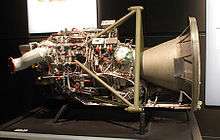VS-30
 | |
| Function | Sounding rocket |
|---|---|
| Manufacturer | Instituto de Aeronáutica e Espaço |
| Country of origin | Brazil |
| Size | |
| Height | 5 m (16.40 ft) |
| Diameter | 0.56 m (1.83 ft) |
| Mass | 1,400 kg (3,000 lb) |
| Stages | 1 |
| Capacity | |
| Payload to LEO | 500 kg |
| Launch history | |
| Status | Active |
| Launch sites |
Alcântara Andøya Barreira do Inferno |
| Failures | 1 |
| First flight | April 28, 1997 |
| First stage - S-30 | |
| Engines | 1 Solid |
| Thrust | 102.00 kN (22,930 lbf) |
| Burn time | 20 seconds |
| Fuel | Solid |
The VS-30 is a Brazilian sounding rocket, derived from the Sonda 3 sounding rocket's first stage.[1] It consists of a single, solid-fuelled stage, and has been launched from Alcântara, Maranhão, and Parnamirim, Rio Grande do Norte, in Brazil, and Andøya in Norway.
It has been launched both on its own, or in the VS-30/Orion configuration, with an American Orion upper stage.[2] On its own, it can reach an apogee of 140 kilometres,[1] and with an Orion upper stage, it can reach an apogee of 434 kilometres.[2] The VS-30 is also used as the upper stage of the VSB-30 rocket.
Flights[3]
- VS-30 XV-01 - "DLR AL-VS30-223 test" - 1997 April 28 - Apogee: 128 km
- VS-30 XV-02 -"DLR AL-VS30-226" Aeronomy mission - 1997 October 12 - Apogee: 120 km
- VS-30 XV-03 -"DLR AL-VS30-229" Aeronomy mission - 1998 January 31 - Apogee: 120 km
- VS-30 XV-04 -"Operação São Marcos" Microgravity mission - 1999 March 15 - Apogee: 128 km
- VS-30 XV-05 -"Lençois Maranhenses" Microgravity mission - 2000 February 6 - Apogee: 148 km
- VS-30 XV-06 -"Cuma Microgravity mission" - 2002 December 1 - Apogee: 145 km
- VS-30 V07 -"Angicos GPS technology mission" - 2007 December 16 - Apogee: 120 km
- VS-30 V08 -"Operação Brasil-Alemanha" - 2011 December 2 - [4]
- VS-30/Orion -Scramspace I - 2013 (launch failure)[5][6]
- VS-30 V13 - EPL-MEL5 ("Estágio Propulsivo a Propelente Líquido") - "Operação Raposa"- 2014 September 1 - L5 liquid rocket engine test for 90s, total flight time 3m34s[7][8][9][10] - 2014 September 01
- VS-30/Orion V11 - ICI 4 - 2015 February 19 [11]
- VS-30 V11 - WADIS 2 - 2015 March 05 [12]
- VS-30 V12 - SPIDER / LEEWAVES - 2016 February 2 [13]
- VS-30 - HIFiRE 5b - 2016 May 18 [14]
Characteristics
- Length (mm) 7428
- Payload Mass (kg) 260
- Diameter (mm) 557
- Total takeoff mass (kg) 1460
- Apogee (km) 160
See also

Brazilian VS rocket family
References
- 1 2 Encyclopedia Astronautica - VS-30
- 1 2 Encyclopedia Astronautica - VS-30/Orion
- ↑ http://space.skyrocket.de/doc_lau_fam/s-30.htm
- ↑ http://www.cta.br/noticias/estrutura.php?id=320
- ↑ https://www.uq.edu.au/news/article/2013/09/scramspace-team-awaits-further-information-launch
- ↑ http://barentsobserver.com/en/business/2013/09/failed-rocket-lands-near-town-center-19-09
- ↑ http://www.iae.cta.br/?action=noticia&id=270
- ↑ http://www.aeb.gov.br/atividade-espacial-no-pais-foi-debatida-em-reuniao-no-cla/
- ↑ http://www.aeb.gov.br/brasil-faz-teste-inedito-com-foguete-movido-a-propulsao-liquida/
- ↑ http://space.skyrocket.de/doc_lau/vs30_epl-me.htm
- ↑ http://space.skyrocket.de/doc_lau_fam/s-30.htm
- ↑ http://space.skyrocket.de/doc_lau_fam/s-30.htm
- ↑ http://space.skyrocket.de/doc_lau_fam/s-30.htm
- ↑ http://space.skyrocket.de/doc_lau_fam/s-30.htm
| Wikimedia Commons has media related to VS-30. |
This article is issued from Wikipedia - version of the 10/12/2016. The text is available under the Creative Commons Attribution/Share Alike but additional terms may apply for the media files.
